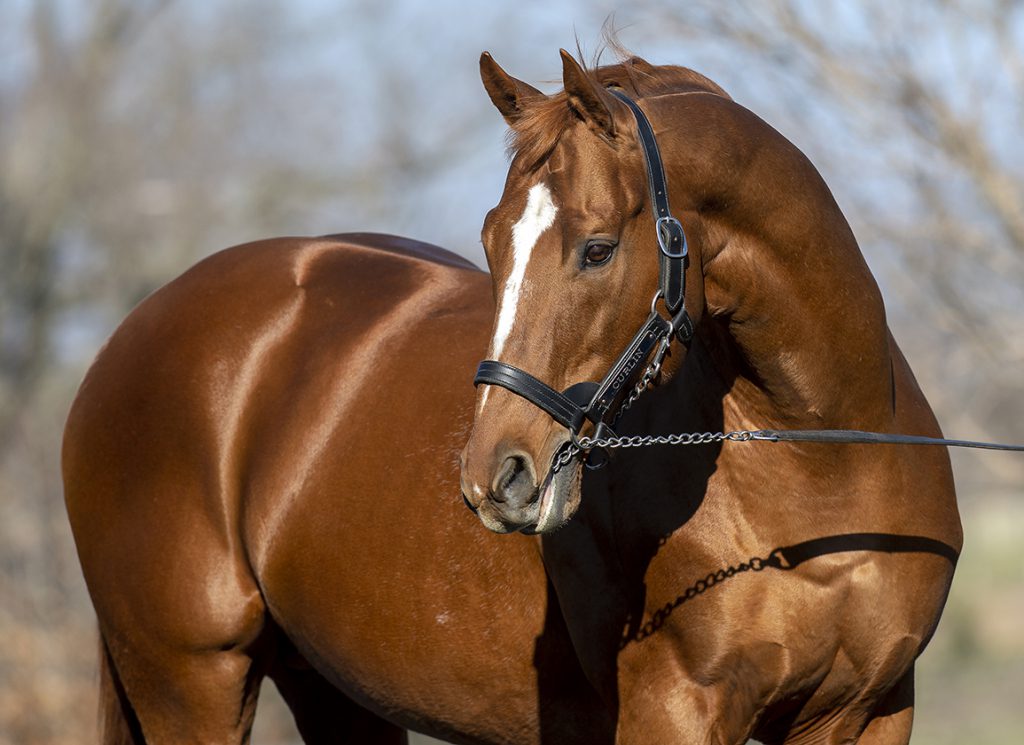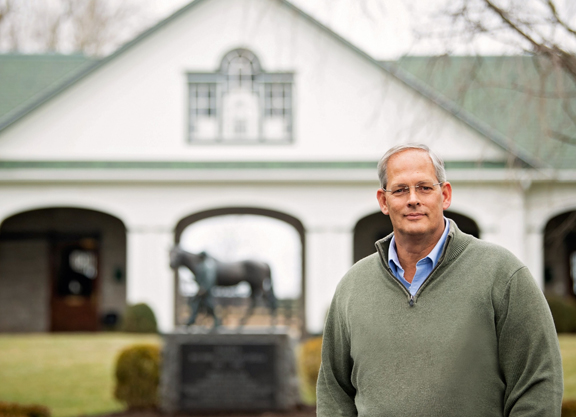They say that beauty is in the eye of the beholder, but in the case of one of the world's most precious broodmares it has so far been a case of “look but don't touch.” That's all about to change, however, with the inclusion in Fasig-Tipton's freshly-minted Saratoga catalogue of a colt by Curlin out of Beholder (Henny Hughes). This is the first of the Hall of Famer's foals to be offered for sale by Spendthrift, a move that reflects a quiet shift of the weathervane as the farm evolves under the regime succeeding its late owner, B. Wayne Hughes.
This is headed by Hughes's daughter Tammy and her husband Eric Gustavson, with continuity provided by general manager Ned Toffey. All emphasize their determination to respect the Hughes legacy, while continuing to build and adapt.
The very fact that a breeder will now have an opportunity to buy into one of the modern breed's most remarkable families is a case in point. For the innovative stallion program developed by Hughes proved so successful, above all through the phenomenal rise of Beholder's sibling Into Mischief, that it has required a parallel upgrade in the broodmare band. This trend has felt increasingly conspicuous, both in the last stages of Hughes's life and during the two years since his loss.
“In the past, we used to bring in a lot of mares that would sort of add to the middle,” Gustavson acknowledges. “And Tammy and I have come to the conclusion that we would like to add to the top of our broodmare band, and have some of these big-time mares to breed to big-time stallions. Certainly Into Mischief qualifies as one of those.
Of course that's our primary model, the stallion, so we're always trying to bring in the next big thing. And now we want the big-time mares to go with the big-time stallions.”
Spendthrift duly gave $9.5 million for Monomoy Girl (Tapizar) at the Fasig-Tipton Fall Mixed Sale of 2020, alongside the $4.2 million Bast (Uncle Mo) and $2.75 million Got Stormy (Get Stormy). In their slipstream followed a series of other striking acquisitions, such as Paris Lights (Curlin) for $3.1 million at the 2021 Keeneland November Sale. But this rebalancing, in turn, has now prompted a shift of strategy with the kind of stock now being produced by the home herd.
“Under Mr. Hughes, we generally offered nearly all of our yearlings at auction,” Toffey explains. “There's always been sort of an emotional attachment to Beholder and her offspring. But one of the things that we've talked about since his passing is that it's important we continue to run Spendthrift as a business. We've kicked around a lot of ideas. We talked about keeping a lot of the offspring, becoming a little more of a breed-to-race operation. But at the end of the day we feel like this is a business and we need to continue to run it that way.
“We had a decision not just with Beholder this year, but with a lot of these other wonderful mares. We've a tremendous foal crop, and some really nice horses will be in the pipeline in the coming years. So we had to make a decision: are we going to keep all these, or are we going to make them available to buyers? And we felt like if all we're going to do is take our culls out there, it doesn't send a great message for those horses. We realize that we can never know where the best racehorses will come from. Sometimes it won't be from the elite. But we want buyers to see that we're going to make our best horses available, and give them a shot to do well with them.”
“That's the first thing you would want somebody to understand,” agrees Gustavson. “That we're definitely not unloading. And I think by selling these types, you're proving that you're not just unloading your culls, but you're selling what you think is the best of your best. And we hope that brings a kind of different mindset to the buyer, so that they're thinking, 'Wow, these guys are selling serious horses.'”
That determination makes a real poster boy of Beholder's colt, who is expected to match his billing as Hip 165 in the Taylor Made consignment. Toffey reckons Curlin to have been “a bit of a no-brainer” as a mate for Beholder in 2021, and the Hill 'n' Dale stallion has only reinforced his reputation since.
“It felt like she had enough speed to suit Curlin, who tends to get a little more of a Classic type,” Toffey reasons. “And we've got a physical that would suggest that's what we've got. He's really an attractive, athletic, strong colt. Great mover, got great presence to him. We're really excited about him, particularly with sons of Curlin taking off, like Good Magic.”
Evidently the colt also has the temperament required at the Saratoga sale, where traffic through the sales complex is so hectic.
“This is a colt that's got a great mind,” Toffey says. “You know, there's an intensity about him but also great intelligence and he takes everything in stride. And Saratoga is just a magical place to take a marquee horse. There's just an incredible atmosphere, and we're looking forward to capitalizing on that. This is the kind of horse that you like to take there: let him show himself off to all the top buyers, and see what he can do.”
In her young breeding career—this is her fifth foal—Beholder has recently made an important breakthrough with third foal Teena Ella (War Front), who won the GIII Senorita S. at Santa Anita in May, only her second start after breaking her maiden. And that's despite Toffey reckoning Teena Ella to be a somewhat less impressive specimen than some of her younger siblings.
“But we began to realize that she had some athletic ability,” he says. “Richard Mandella's done a great job in managing her, and she's now a graded stakes winner. And you know, for Beholder to have her pedigree, race record and looks, and now to add graded stakes producer to her resume—that puts her in an incredibly elite group of broodmares.”
Moreover her 2-year-old by Bolt d'Oro has been evidently been exciting Mandella and his team.
“By all accounts he seems to have the most ability of those we've seen so far, including the Grade III winner,” Toffey discloses. “That's got to be proven out, but the early reviews are very, very good. So hopefully Beholder is really just getting started now, and seems to have figured the broodmare game out. The pipeline seems pretty loaded and we feel that this colt, physically, has a different look about him. He's got all the tools and hopefully will put all that together.”
In starting her own contribution to the dynasty, Beholder can now render still more extraordinary the story of Leslie's Lady, the Tricky Creek mare who was perceived as offering little genetic credibility when Into Mischief started out. Since then she has proved herself an authentic blue hen through the endeavors of Mendelssohn (Scat Daddy) and Beholder herself.
“It really is remarkable,” agrees Toffey. “As Mr. Hughes used to like to say, 'Nobody knows.' When Into Mischief first went to stud, people really questioned his pedigree. It's amazing the way things unfold. Given a little bit of time, it has now become one of the most spectacular pedigrees in the American Stud Book. So it's been a great ride. I don't think anybody could have expected everything to happen the way it did. But, you know, breeding is a game that requires patience. And if you do show a little of that, you can really be rewarded.”
That length of perspective has also served some of the strategic shifts being made by the Spendthrift boardroom. Weighing up the context, Toffey explains: “You know, early on, we had a relatively modest stallion roster, with a couple of exceptions. And it's always been important for us to have a broodmare band that we can utilize to support our stallions at an appropriate level. Gradually we've been fortunate enough to increase the quality of our stallion roster, and so we really felt it important to upgrade the quality of the broodmare band to go along with that. And now we're fortunate to have some really high quality stock roaming the grounds here.”
Having been broodmare manager at Three Chimneys prior to his recruitment by Hughes in 2004, Toffey does not deny feeling an extra fulfilment in this new chapter of the Spendthrift story.
“I really have,” he says with a smile. “Mr. Hughes would actually give me a hard time pretty regularly about being a broodmare guy, and I am a little biased. I do believe that the broodmare plays a huge role, and probably an underrated role, in all of this. I really believe that the strength of any organization is its broodmare band. If you go through history, you see how the fortunes of many farms rise and fall on the backs of a small number of really successful broodmares.”
That said, quality will remain complemented by quantity. “This is a numbers game,” Toffey argues. “You've got to go through a lot of horses to find those really special ones. But we've got ownership here that's excited and committed to try and bring in, and produce, the best quality that we can.”
And that's a matter of evolution rather than revolution.
“Wayne was such a visionary, and so successful in almost everything he did, that we'd be foolish not to try thinking about how he would have gone about things,” Toffey reflects. “At the same time, over the years Tammy and Eric have gotten very familiar with how to go about things, and they bring a lot of their own ideas as well.”
The evolution of the program will also be evident at the Keeneland September Sale, where the young bloods on the Spendthrift roster will once again be making their presence felt.

Curlin at Hill 'n' Dale at Xalapa | Sarah Andrew photo
“We've got a really nice group of yearlings going to Keeneland, highlighted by our first-year sires Authentic and Vekoma,” Toffey says. “We're getting great feedback from breeders about both. Meanwhile our freshman sires have gotten off to a great start, right now we've got four of the top five, and we'll have a number of offerings by those stallions as well. Our Keeneland consignment is probably highlighted by a colt that Elite Sales will be selling for us, by Into Mischief out of Bast: obviously a tremendous pedigree, and a really impressive physical, so a horse that we're really excited to offer to buyers.”
In terms of the bigger picture, meanwhile, Gustavson professes admiration for the multi-faceted elaboration of quality to be observed such rival programs as Stonestreet.
“Obviously this is not a unique idea, what we're doing,” he acknowledges. “A lot of things that people do are just copied from competitors or friends/competitors, and that's just what we're doing here with a sort of Stonestreet model. You've got big-time mares, you still race, but you are known as someone who sells Grade A foals.”
Many other farms, equally, have emulated the brand of commercial dynamism introduced to the Bluegrass by Hughes. And Gustavson concludes by reiterating a fidelity to his father-in-law's pioneering legacy.
“We would always want to honor the past and sort of add our own flair to it, if you will,” he says. “I mean, Wayne was a bigger and better businessman than I'll ever even think about being, so there's no competing there. He did a lot of things that were very innovative, and very disruptive, and we have benefited from those over the years.
“I learned so much from him. So for Tammy and I, along with Ned and our team, it's not like we were thinking, 'Well, if we ever take the reins, this is what we'll do.' It's just the time has come where we are blessed with the opportunity to try some different things. That's where the buying of higher-end mares comes from, and we switched some things up at the farm [as well]: in terms of our protocols, in terms of the numbers we're breeding, and then also now obviously selling the top lots that we've ever had, this summer and early fall.
“We're so humbled by the opportunity to be able to carry on Wayne's legacy, and we hope that we can do it justice.”
The post Don’t Just Breed the Best to the Best–Sell Them, Too appeared first on TDN | Thoroughbred Daily News | Horse Racing News, Results and Video | Thoroughbred Breeding and Auctions.


